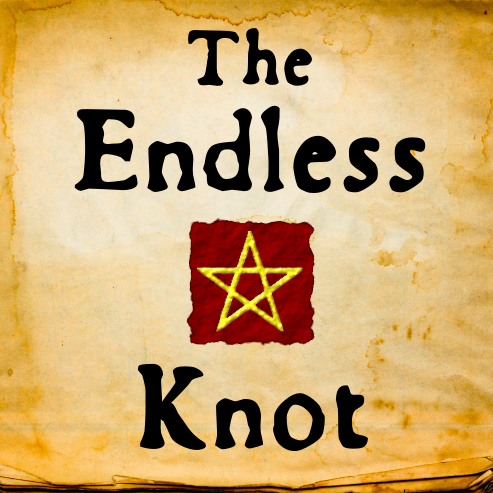"Thousand" Transcript
By Mark Sundaram
Welcome to the Endless Knot! We’ve just reached 1000 subscribers! Thank you! Thanks for watching, subscribing, sharing, and commenting! Your interest and support is what makes this all so much fun and so worthwhile. So, there seems no better way to mark this milestone than to talk about the etymology of 1000!
Thousand is actually a compound word, the -and part being the same as the hund- part of hundred, and going back to the same Proto-Indo-European root that produced Latin centum also meaning “hundred”, as in centimetre, a hundredth of a metre. The -red part of hundred, by the way, means “number” or “reckoning”, so hundred literally means “the number hundred”. But the hund- part itself has two components: the first part means “ten” and gives us both the word ten and words such as decade and decimal. And then it has a suffix on the end which raises it from ten to hundred. This ten root, by the way, gives us the -teen part of 13, 14, and so forth, and also the -ty part of twenty, thirty, and so forth, meaning literally “two tens” and “three tens”. But getting back to thousand, the first part of that word come from a Proto-Indo-European root that means “to swell”, so literally thousand means “swollen hundred”. It probably originally didn’t refer to a precise number, meaning something more like “a great many”, but eventually came to mean ten hundreds. That “swelling” root, by the way also gives us words such asthumb, thigh, tumour, tuber, and tomb. And the second element of butter. The first part of butter comes from Greek bous, which means and is related to the word “cow”, about which you can learn more in our video “Beef”. The second part of butter comes from Greek turos meaning “cheese”, so literally “cow-cheese”, coming from that “swelling” root in Proto-Indo-European in reference to the fermentation of the cheese making process.
Of course, speaking of a hundred, a hundred, at least in Germanic languages, did not originally mean 100. It originally meant 120. But when Latin arrived on the scene with centum referring to the number 100, the word hundred eventually changed its meaning. To avoid confusion the two ways of counting can be distinguished, with the newer count called “tentywise”, that is by tens, and the old sense of hundred called “the long hundred”. Many have speculated that this implied that early Germanic peoples used a base twelve system, but this is only sort of true. Another piece of evidence for this is that eleven and twelve are different, from the other teens — not oneteen, twoteen, thirteen — but they’re still reckoned from the 10. So eleven means literally “one left” after the initial count of ten, and twelve is similarly two left (after the initial count of ten). So it’s still really a base 10 system.
A similar kind of number inflation happened with the word million. Million comes from Latin mille meaning “thousand”, but with the addition of a suffix for emphasis it increased in size to a thousand thousands. From Latin mille, by the way, we get the prefix milli- as in millimetre, a thousandth of a metre, and the word mile, which was originally a thousand paces. Mille is also related through Greek to the prefix kilo- as in kilometre, a thousand metres, so a mile and a kilometre are, it turns out, etymologically related!
I’ve mentioned the metric unit of measurement, the metre, a number of times, and that’s where this linguistic reckoning brings us next. Metre, metric, and measure all come from the same Proto-Indo-European root, which also gives us moon and month, thus measures of time, and meal, a time appointed for eating, whose earlier sense of a measure or quantity is still preserved in the compound word piecemeal.
To round out the imperial vs metric discussion, a quick word about the inch, to balance my earlier mention of the centimetre. Inch comes from Latin uncia meaning “one twelfth part”— there’s that idea of a possible base twelve counting system again—ultimately from Latin unus meaning “one”, and is cognate not only with English one, but also any, lone (one really is the loneliest number), and ounce, another unit of measurement. Inch and ounce were borrowed into English from Latin uncia at different times, first in pre-Old English Germanic and then again in Middle English, and so the words underwent different sound changes over the years. One inch is a twelfth of a foot, and one ounce ought to be a twelfth of a pound—and was at one point—but now according to the standard avoirdupois system there are 16 ounces to the pound, though the troy system, used exclusively for precious metals, still has the etymologically correct twelve ounces to the pound. An inch was defined in the medieval period as the length of three barleycorns. However, the Scottish King David I in the 12th century supposedly defined the inch as the width of the average man’s thumb at the base of the nail. Which brings us back to the word thumb.
And so, as we measure up and reach this milestone, here’s a big thumbs up to all our viewers — thanks a million! If you’ve enjoyed these etymological explorations and cultural connections, please subscribe to this channel or share it; you can also sign up for email notifications of new videos in the description below. And check out our Patreon page, where you can make a contribution to help me make more videosLeave a comment or question, or tweet @Alliterative; you can also read more of my thoughts on my blog at alliterative.net.
